The Yellowstone to Yukon Initiative Hopes to Give Wildlife Room to Roam
It's a big, inspiring vision of wildlife connectivity. But could it work?
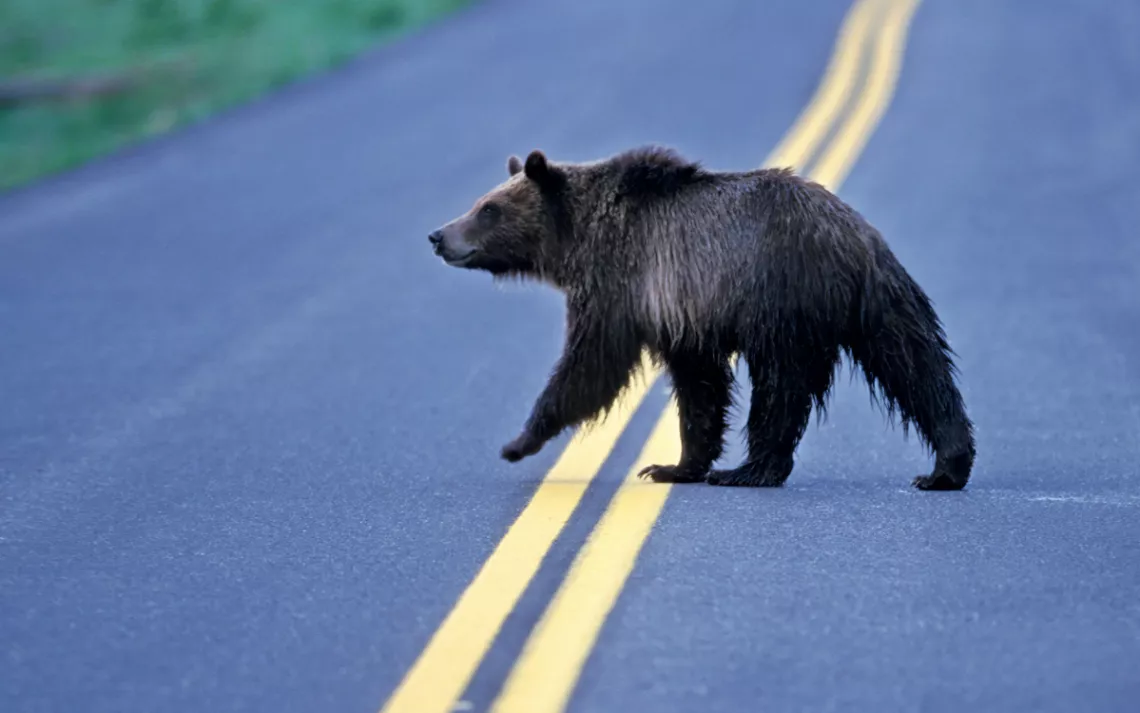
Photo by Florian Schulz
IT WAS EARLY July when I drove north through Wyoming. For hours, the world stretched out, arid and desolate. Then something miraculous happened: The land began to curve and convolute, twisting and then greening. Better yet, I came upon one of the most graceful and beautiful animals on the planet—pronghorn. They were everywhere, with curved black horns, their coats tawny brown and vivid white. A sign—"Caution, Antelope Entering Highway at 55 mph"—reminded me that these delicate creatures are the continent's fastest land mammals.
I had seen plenty of pronghorn in my life, yet somehow I'd managed to never see one do what they do best—run. Soon enough, I got my chance as a pronghorn shot in front of my car. The animal seemed to have a hard time gaining purchase on the asphalt, its hooves skittering across the road, but still it was moving at an astounding speed. Which was good, or I would have hit it straight on.
A friend once explained to me that the pronghorn evolved so that it could get away from the now extinct American cheetah. With the cheetah long gone, the pronghorn is much faster than any predator remaining on the continent. Except for one: the North American car.
A STORY WAS leading me northward. The story had the simplicity of a fairy tale, and it went like this: Imagine if, in an age of extinction and climate change, we could build a pathway along the spine of North America that animals could traverse, a path that would give them enough room to migrate and continue to transfer genetic material to other populations. A path that, above all, would allow wildlife to continue to evolve. The story had a kind of Noah's Ark vibe to it. Best of all, it was real.
"The story grew out of the science," Harvey Locke, a Canadian conservationist who came up with the idea around a campfire in the Northern Rockies of British Columbia in 1993, told me before my trip. "Parks were a brilliant idea, and without parks we would have not just lost land but species. Parks work. But science began to teach us that parks could be improved on. For species like wolves and bears, who can migrate thousands of miles, parks are not enough."
The science that the story grew out of was conservation biology, which sprang from the findings of what's known as island biogeography. That science taught us that islands, particularly remote, small islands, are hotbeds of extinction. Eventually, conservation biologists arrived at a distressing corollary: Parks and preserves, even the biggest ones, have become islands. In response, conservation biologists began to imagine creating pathways of wildlands to connect those islands. The particular pathway that Locke and others had in mind would protect large mammals, and it would stretch from the Greater Yellowstone Ecosystem in the United States to the Canadian Yukon. Since 1993, the Yellowstone to Yukon Conservation Initiative (Y2Y) has worked with state, provincial, and national governments, Indigenous tribes, and private landowners to help protect some 59 million acres as part of this continental-scale rewilding scheme.
"My hope is that Y2Y can be an example of how we address two of the biggest challenges on Earth: biodiversity and climate change," Jodi Hilty, who has been president of the organization since 2015, told me. "That it can be a guiding star for Gen Zers and millennials, who often feel without hope."
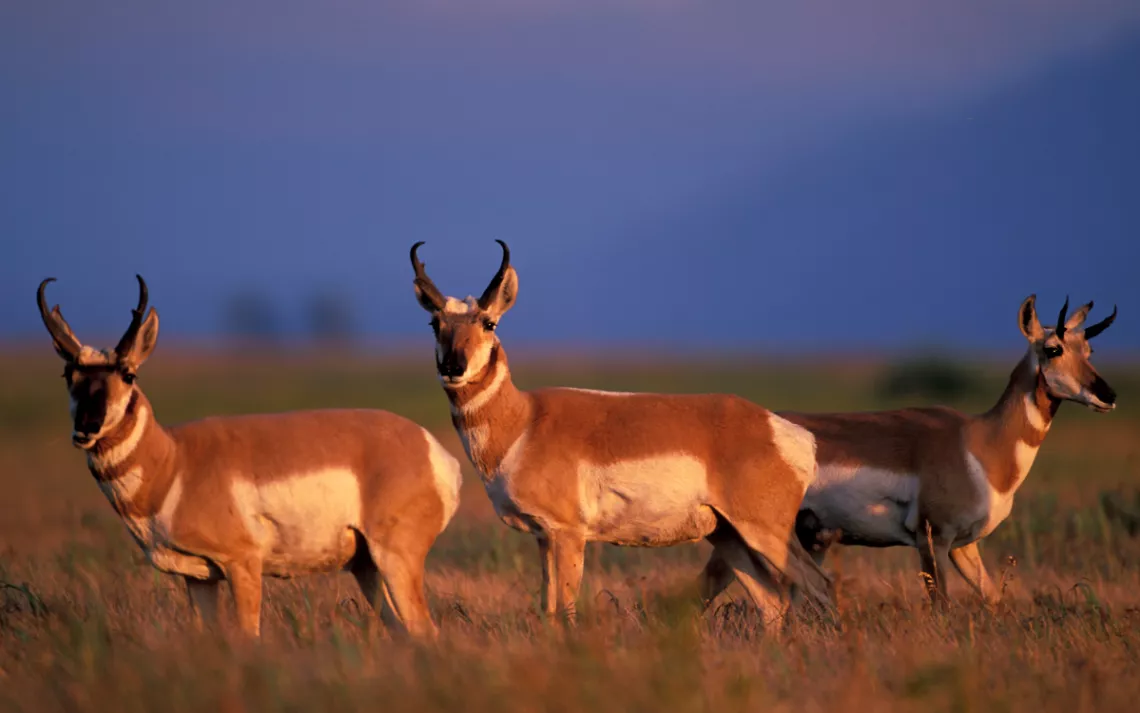
Populations of pronghorn and grizzly bears are increasingly isolated by roads and other human development. The Yellowstone to Yukon corridor aims to connect them. | Photo by Florian Schulz
I'm a graying baby boomer with ailing knees, not a millennial or a Gen Zer. But like many people these days, regardless of age, I have found myself increasingly hungry for hope, eager for some evidence that we are not witnessing the end of Earth's wild places. During the weeks I spent tracing the route Y2Y imagines, I would get some of that hope I was looking for—along with some healthy dollops of hard reality.
WHEN TALKING about the Y2Y corridor, it is best to start with grizzly bears. "Protect the grizzly and you protect the rest," as Locke likes to say.
By the rest, he means everything from sage grouse to marmots to glacier lilies. The grizzly is a keystone species, an ecosystem engineer. Conservation activists sometimes refer to it as an "umbrella species." If you protect bears, you end up protecting the scores of smaller species that share the bears' habitat, including many endangered species.
"My hope is that Y2Y can be an example of how we address two of the biggest challenges on Earth: biodiversity and climate change."
Since grizzlies were my focus, my first stop was in Emigrant, Montana, home of one of the most passionate, and certainly the fiercest, defenders of grizzly bears in the country. Bearded and blunt, Doug Peacock is a living legend. Beyond his reputation as the monkey-wrencher who inspired Edward Abbey's Hayduke character and the guy who lived with grizzlies—the real grizzly man—he has a dark secret. He is a nice and generous man. Sweet even. A few months before my trip, I had written Peacock to ask if I could visit. Then 81, he replied that he wasn't certain he would be alive in the spring. But it turned out Hayduke lives.
Peacock has spent his adult life fighting on behalf of Ursus arctos horribilis. As a field medic in Vietnam, he had kept a folded map of Yellowstone in his pack, and when he flew home from the war, his body sick from malaria and his head filled with bloody images of destruction, he headed to the backcountry of the national park, where he lived off-grid for months at a time over the course of two decades. His neighbors were 600-pound carnivores, and he got to know those neighbors well, watching them, interacting with them, filming them, and ultimately advocating for them.
Peacock's backyard, where we sat and talked, happened to be Paradise Valley, the natural corridor for bears and wolves traveling north out of Yellowstone. "We've got to give the explorer bears a chance to live," he told me. "You can't kill them just because there are people everywhere. The big mammals, especially the top mammals—you've got to let them wander."
Peacock whipped through a list of things that impede that roaming. Development, hunting, livestock, and the Montana legislature, which had recently passed eight laws to allow even more hunting of apex predators and was now determined to get the grizzly delisted as an endangered species. The old days, when political conservatism and conservation happily mixed in Montana, are long gone.
"The Yellowstone bears will in time go extinct if there's no connectivity," Peacock continued. "They're besieged by climate change. The whitebark pines are gone. The habitat is degrading."
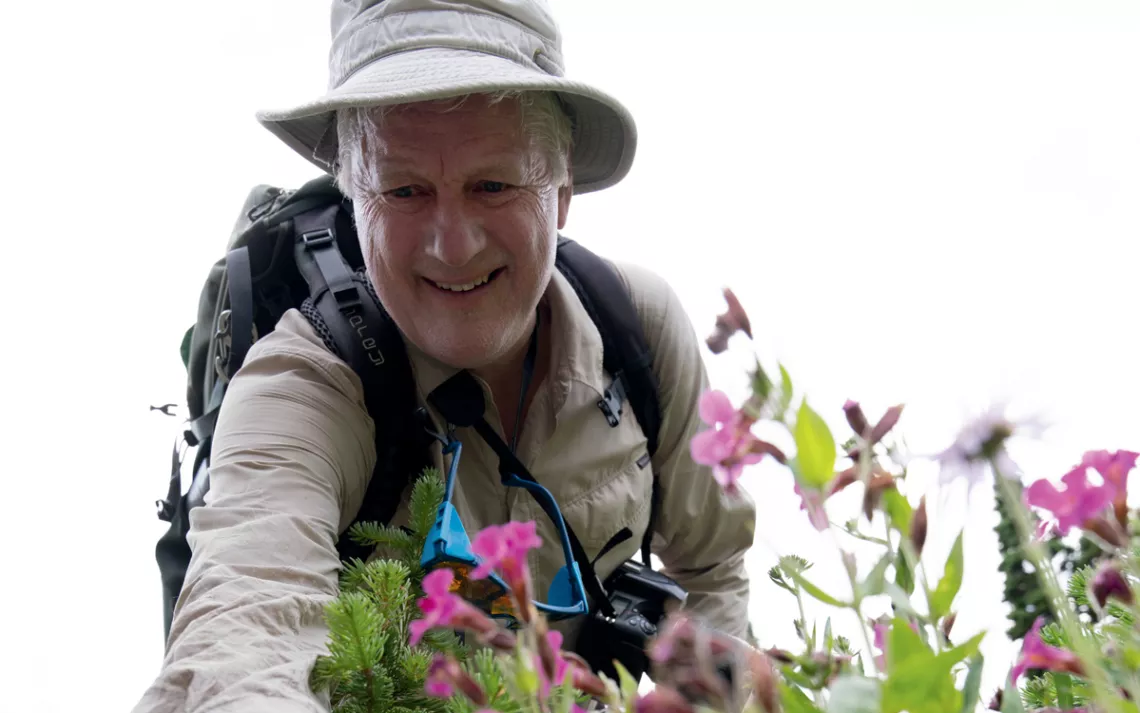
Harvey Locke, an environmental lawyer turned conservation activist, got the idea for the Yellowstone to Yukon corridor while on a camping trip in the Canadian Rockies in 1993. | Photo by John Price
The nuts of the whitebark pine are a staple food source for grizzlies. But the pines are dwindling, he explained, because warming temperatures and a lack of deep frosts have allowed an exotic disease called blister rust to kill off the trees at 8,000 feet and higher. Which emphasizes a point I would hear again and again: It isn't just animals that need to migrate in the age of climate change. Their habitats, including plants, trees, flowers, and fungi, are also on the move.
Eventually the conversation came around to Michael Soulé, Peacock's friend and the founder of conservation biology. "To save species, we must save habitat," Soulé had told me when I visited him in Paonia, Colorado, not long before he died in 2020. "And those habitats must be connected." But, Soulé said, connection is complicated in this hard and warming world. "If large carnivores can't migrate, if species hit a hard barrier, it does not bode well for their survival."
Roads are one of the hardest of the hard barriers. In his book about road ecology, Crossings, Ben Goldfarb writes, "If you're a Kerouac reader, you grew up steeped in the dogma that highways represent freedom. If you're a grizzly bear, they might as well be prison walls." Yellowstone to Yukon may have a nice alliterative ring to it, but Interstate 90 runs like a border wall just north of Yellowstone National Park, threatening, in the words of Locke, to make Yellowstone as "orphaned as an island."
"We have evidence now that female grizzly bears pass the knowledge of using the overpasses on to their cubs."
Peacock agreed. "I-90 is it. Yellowstone to Yukon sounds good. They do a great job of publicizing themselves, but it doesn't mean shit if bears can't get to Yellowstone. And they can't because of the fucking highway."
But there is hope, he added, and hope of the concrete, not the ethereal, sort. Add an underpass or two, or even more ambitiously (and expensively) an overpass along with highway fencing, and you would link the Greater Yellowstone Ecosystem with the multiple wildlands to the north. In fact, bears and mountain lions and moose and elk are not waiting on the Montana Department of Transportation to create an official wildlife corridor. They are taking matters into their own hooves and paws by using unofficial ones.
The next morning at dawn, I explored one of those. It was a small underpass, not too much more than a culvert really, below I-90, with a rippling creek providing a counterpoint to the occasional whine and roar of trucks above. It wasn't the most peaceful residence for the cliff swallows swooping down from their mud homes plastered to the underside of the bridge, but the swallows, like other creatures, have managed to make do. While Peacock might have been able to read the dirt, the only tracks I could discern belonged to tires. But the place had a musky smell, and next to the creek was a path wide enough for bears to amble through white sage, smooth brome, and crested wheatgrass. To the north, there was only a flimsy wire fence and railroad tracks, and beyond that an unbroken route off to the mountains. As the red-ball sun rose, I could picture it: a pathway north. Create a half dozen more such animal corridors, add some fencing, and suddenly you'd have a real Y2Y pathway instead of a clogged artery.
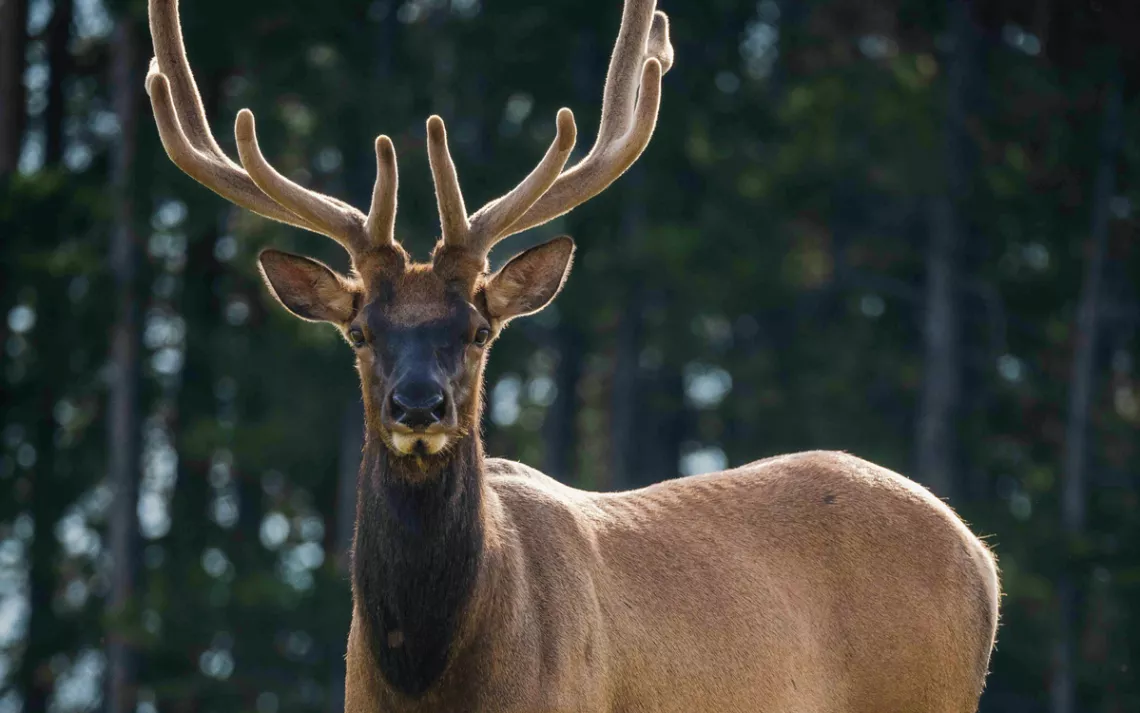
The place where Glacier National Park meets the Canadian Rockies is the great ecotone of the Yellowstone to Yukon corridor. Harvey Locke argues that it's "the most important wildlife corridor in North America." | Photo by John Price
Later that day, I headed into Bozeman and paid a visit to a man who was one of the guiding spirits of my summer journey. David Quammen wrote The Song of the Dodo, a comprehensive history of island biogeography and conservation biology from the days of Darwin and Alfred Russel Wallace to those of E.O. Wilson and Soulé. Given this, I expected Quammen, who sat across from me in his book-lined study, to be a fan of the Y2Y corridor. Instead, he regarded the idea with what I gathered was his habitual skeptical intelligence.
"Grandiose" was his description.
"With all due respect to my friends who have been involved in Y2Y, I find it pie-in-the sky and in some ways irrelevant," Quammen said. "No animal, however large, however migratory, needs all that connectivity. There is a lot of sub-connectivity in between those two places that is immediately crucial."
Quammen told me that he doesn't have "any philosophical objection to Y2Y." He does, though, have some strategic and tactical objections. His focus is on the tangible, the local, the practical, and the politically doable, not on the vague and large. The bigger vision, he said, "doesn't get my juices flowing."
Then I mentioned exploring the underpass earlier that morning. Quammen popped out of his chair and dug out a well-used road atlas, which he was soon looking at through a magnifying glass. "I'm a great believer in maps," he said, pointing at a spot just east of Bozeman where I-90 traverses Bear Canyon.
"Right here is what I'm talking about. One overpass would add the entire Bangtail range to the Greater Yellowstone Ecosystem. I haven't measured this, but I would guess that it would add in the vicinity of a thousand square miles of forested mountain grizzly habitat that is currently empty of grizzlies."
That's the good news, but it is balanced by the current reality. While there are 22 million acres of what Quammen called wild and "wildish" land in the Greater Yellowstone Ecosystem, and optimistic estimates say there are about 1,000 bears, those bears are susceptible to threats other than the obvious ones. He explained that the grizzlies of Yellowstone eat more than 260 food items, but just a handful constitute their main energy sources: army cutworm moths, cutthroat trout, ungulates, and whitebark pine nuts. "Those four items all have threats against them," he said.
Peacock had mentioned the whitebark pines. Quammen now told me that the other three foods are also "hostage to things that are going on." The moths are hostage to agricultural practices as farmers seek to kill the caterpillars the moths begin as; the cutthroat are being muscled out of Yellowstone streams by introduced lake trout; and wolves in the park mean competition with bears for elk meat (the elk are further threatened by the fact that their winter range is on unprotected private land). "So the four most crucial food sources for the Yellowstone grizzly all have nooses around their necks."

The place where Glacier National Park meets the Canadian Rockies is the great ecotone of the Yellowstone to Yukon corridor. Harvey Locke argues that it's "the most important wildlife corridor in North America." | Photo by John Price
One of the central ideas of island biogeography is that isolated populations are particularly vulnerable to disease and disaster. The grizzly threats Quammen described would not be eliminated by what Peacock called "room to wander." But they are certainly exacerbated by the barriers to migration. A species' margin for error dwindles when the acreage it has access to does. "I love a broad margin to my life," Thoreau wrote. Grizzlies do too.
From Bozeman, I drove to Yellowstone, where, that evening, I saw the trip's first grizzly, cinnamon-backed and darker by the butt. It was eating what appeared, to my unprofessional eye, to be dandelions, presumably one of its 250-some-odd secondary foods.
The next morning, I visited with Joanna Lambert, or "Indiana Jo," as her students sometimes call her. We met at the Yellowstone Forever Institute's Lamar Buffalo Ranch, a historic spot that was home to the reintroduction of wolves in 1995 and the park's famous first reintroduction, that of bison, in 1902. Lambert, a research scientist at Yellowstone and a professor at the University of Colorado, wore a cowboy hat and threw herself into our conversation with energy and humor; I could see why her students love her. As we hiked up the trail behind the institute's campus, we had to make detours to avoid the bison—"Pleistocene impediments," she called them—big bulls that looked at us sideways. Our destination was the famous pen where the first reintroduced wolves were held before their release, now preserved as a kind of dilapidated shrine.
"The current wolf status is that there are about a hundred animals in the park, distributed in 10 packs," she said. "There's been a lot of social chaos in those packs since the hunt a couple of years ago."
She was referring to the 2021 wolf hunt, which was the result of Montana governor Greg Gianforte increasing the quota of animals that could be killed right outside the northern edge of the park. "There were folks just lined up with their rifles," waiting for the wolves that wandered off protected land, Lambert said. "They can even use bait to get them to cross." That year, hunters killed 273 wolves in Montana, including 25 Yellowstone wolves, a fifth of the park's population at the time. Many were shot right after they crossed the imaginary line from protected park to unprotected forest. Guns, just like cars, can impede migration.
If Yellowstone is further cut off by hunting and roads and development, there is little question that it will become an island, and that the wildlife there will suffer the same fate as other isolated populations. Then we will have to throw out the feel-good story of how the return of the wolves triggered a trophic cascade that restored the Yellowstone ecosystem. Wolves are epic roamers that won't stay within artificial borders. They need their space. "As humanity chops the world's landscape into pieces, those pieces become islands too," Quammen wrote nearly 30 years ago in The Song of the Dodo. "Islands are where species go to die."
THE BARRIERS TO THE DREAM of connectivity are many. In Canada, Route 3 plays the role of I-90; it's a potential "Berlin Wall of biodiversity," according to Harvey Locke. Other threats include open-pit mining, railroads, and, as usual, housing developments.
There are signs of hope too. Heading north on US Highway 93 through the Flathead Reservation, I drove under my first wildlife-crossing overpass. A highway is not usually an elegant thing, but this was elegant: a bridge of brick arcing over the road, grass growing up top like uncut hair. The overpass looked almost like an intentional ruin, something from the apocalyptic future, except that this ruin is purposeful, allowing animals to cross over the deadly river that is the highway below. While this overpass is the most dramatic wildlife crossing on Highway 93, there are another 80 crossings for animals to use.
This was what Doug Peacock dreamed of for I-90. But here the political reality is different. It is reservation land, and the Confederated Salish and Kootenai Tribes' Flathead Reservation is a sovereign nation. In the early 1990s, when Montana officials proposed widening the then notoriously deadly Highway 93, the Native nation laid down some conditions. Those included animal crossings, as the Salish and Kootenai cited the importance of animals to tribal sustenance, culture, and philosophy. "When we look to the future, crossing structures and connectivity across the barrier that highways pose are a glimmer of hope for wildlife," Whisper Camel-Means, a wildlife biologist with the tribes, told me. "If they can safely move across the landscape, they have a chance to thrive. We owe them that chance."
According to Jodi Hilty, Y2Y has a long tradition of working with First Nations. "Indigenous leadership is the future of large land conservation," she said. Conservation success stories in the Yellowstone to Yukon region include the Sahtú Dene's establishment of the 1.2-million-acre Nááts'įhch'oh National Park Reserve in the Northwest Territories in 2014 and the leadership of the Dehcho Dene in dramatically expanding the Nahanni National Park Reserve to make it the third-largest national park in Canada.
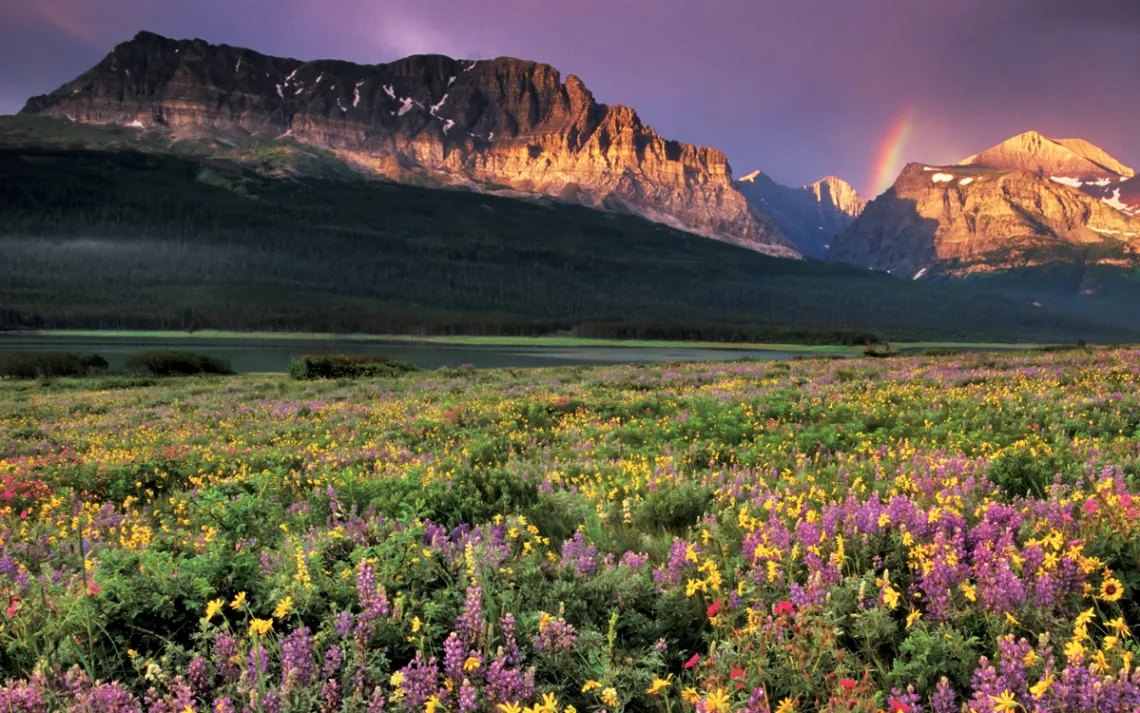
The place where Glacier National Park meets the Canadian Rockies is the great ecotone of the Yellowstone to Yukon corridor. Harvey Locke argues that it's "the most important wildlife corridor in North America." | Photo by Florian Schulz
When the Salish and Kootenai Tribes began studying how to create their own underpasses and overpasses on Highway 93, they looked toward the mecca of animal crossings: Banff. That was where I was headed, and the next afternoon, I pulled over at a rest area not far from the Red Earth overpass, one of the first wildlife overpasses built by Parks Canada in 1996. The overpasses were part of the solution to the problem posed by having the Trans-Canada Highway bisect Banff National Park. To get close to the structure, I walked along the highway parallel to the fencing that ran beside the road. Something there is that doesn't love a wall, said the poet. But also: Good fences make good neighbors. These fences have a purpose, and that is to usher wildlife toward places they can cross. The overpass was two graceful arcing tunnels, topped by pine trees and wildflowers and tall grass.
Before my trip, I'd called Karsten Heuer, the former president of Y2Y. He told me that in the early days, larger mammals were sometimes reluctant to use these crossings but that the longer they've been in place, the more they have been used by migrating animals. "That's a perfect example of adaptability," he said. "Of the resilience of species. We have evidence now that female grizzly bears pass the knowledge of using the overpasses on to their cubs."
Heuer and his wife live in Canmore, 20 minutes down the road from Banff, and they were my generous hosts for the next two days. It turned out that Heuer's personal story is central to the story of Y2Y. While working as a park ranger right out of university and conducting one of the first studies of animal movement in wildlife corridors, he encountered two characters that would change the course of his life. The first was a satellite-collared wolf named Pluie, who opened Heuer's eyes to the continental scale of animal migration. The second was Harvey Locke. When Heuer heard Locke talk about the Y2Y corridor at a local library, he thought, "This is exactly what we need. This is exactly what Pluie the wolf is telling us."
Heuer was intrigued. But, like Quammen, he was skeptical. Pluie aside, how feasible would it be for animals to actually migrate from Yellowstone to the Yukon? Like the good scientist he was, he decided to test the theory. He did so, he told me, "by actually trying to be one of those animals," setting out from Yellowstone in June 1998 and—after some breaks back home—eventually arriving in the Yukon in September 1999. During his trek, he watched herds of caribou running through the snow, encountered grizzlies and black bears face-to-face, and had the rare pleasure of seeing a wolverine.
"By the time I got to the Yukon, I looked back and there were only 18 days out of 188 when I hadn't seen fresh grizzly sign," Heuer told me. "And most of those occurred in the more developed parts of Montana between Yellowstone and the Continental Divide. I just realized, holy crap, this is feasible. It's mostly there already."
"THIS IS THE KEY. This is where we make it or break it. There is no question that the Yellowstone to Yukon corridor comes together or falls apart in this corridor that runs up the Rockies, from the Flathead River valley through British Columbia through the Elk Valley to Banff."
Harvey Locke and I were standing on top of the rock blade of the Akamina Ridge, near the border of the US and Canada, just west of Waterton Lakes National Park, looking down at the home of the densest grizzly population in the interior of the continent. Earlier we had climbed through a landscape still in the process of regenerating itself after the vast Kenow Fire that blazed through in 2017, hiking our way up through purple-headed fireweed and knee-high lodgepole pine and charred spruce. The climb had led to this sharp ridge, where we were surrounded by a dazzling display of mountains, the Flathead River to the west and Glacier National Park to the south—or what Locke called "the park formerly known as Glacier." The quip was depressingly accurate, but the site of a turquoise lake, for the time being still colored by glacial flour, provided a glimpse of transcendence.
This was the great ecotone of the Y2Y corridor: the Rockies at their narrowest and the preserved land growing even narrower north of the border, as much of the terrain in British Columbia is still unprotected. I asked Locke how important it is to protect this pathway.
"It is the most important wildlife corridor in North America," Locke replied. "And saving this is the single most important thing, I would argue, that we can do for biodiversity and conservation on the continent."
I nodded. It was clearly Locke's nature to think big. You might even call it grandiose.
As we climbed, the wind seemed intent on blowing us off the mountain. An hour later, we reached a meadow where we ate a picnic lunch of nuts and cheese while staring out at yet another wild array of mountains. It is fashionable to say that wilderness no longer exists; it is harder to say those words in such a place. We usually think of wild as ineffable, but the word does have its definitions, and among them are scale, connectivity, and diversity. It's any place where animals continue to migrate, interact, prey on one another, and evolve. The land we were looking at checked all these boxes. But for Locke, it isn't enough. In a time of contraction, he believes that this wilderness has to be expanded.
Back in Canmore, I had mentioned Quammen's comment about the "grandiose" Y2Y vision to Karsten Heuer, who, in response, had nodded thoughtfully. "He is right," Heuer said. "The local fights are what matter most. But I think those fighting the local fights are energized by the larger vision."
Later he elaborated: "A lot of what we have achieved has been due to the power of the bigger vision. The big inspires us, but it also allows us to see the small more clearly. One of the best things about the Y2Y story is that it puts the smaller fights, the local efforts to conserve land, into a larger continental context."
While ground-truthing the Yellowstone to Yukon idea, I'd seen plenty of obstacles and had come to understand that the fantasy of the Y2Y corridor was dented with hard realities. But while I agree with Quammen that the single achievable thing is more important than any vague or gauzy vision, there is something in me that responds to the excitement of the vast, something that parallels how I was feeling as I sat with Locke and stared at hundreds of miles of mountains. Maybe the grandiosity of the Y2Y vision is part of its appeal. In a constricted time, when hope is hard to come by and we often feel powerless, we hunger for the large and visionary.
My mood expanded with the land. I looked down at the wilderness and imagined wolves and grizzlies migrating through the mountain corridors. This was what they need, I thought, more of this. A place where they can live with a wide margin. A place with room to roam.
 The Magazine of The Sierra Club
The Magazine of The Sierra Club



